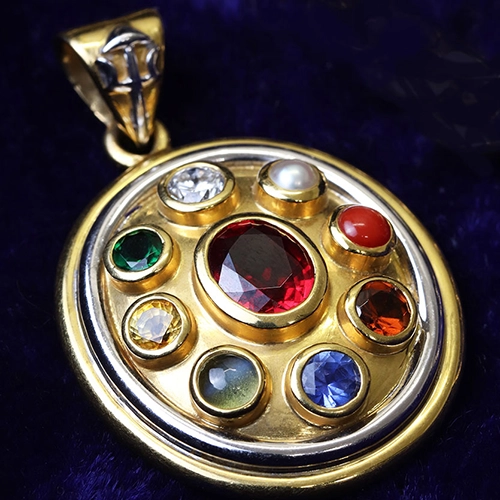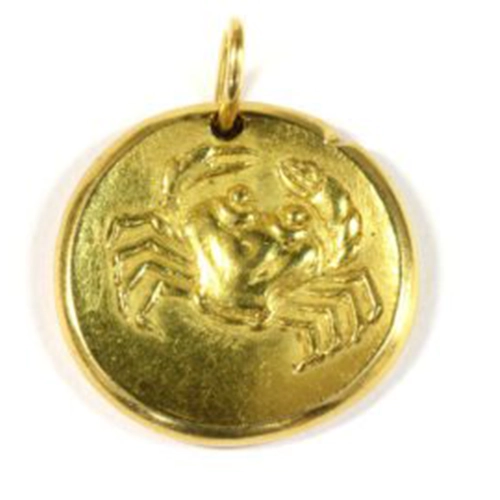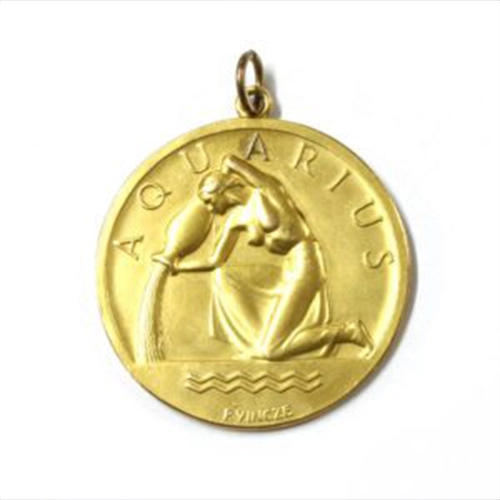06 July 2022
Astrological jewellery: Investments written in the stars?
4 minutes
(Image: ‘Colourful collection: Astral Gemstone Talismans by Richard Shaw Brown’)
The first collection of Richard Shaw Brown’s astrological jewellery has just gone under the hammer and Sworders Fine Art Auctioneers’ jewellery valuer, Catrin Jones, tells Private Clients Director Julie Webb why this ‘magical’ jewellery is back in vogue.
The Swinging Sixties were a defining decade – men aged 18-30 were no longer called up for National Service in the forces – and a cultural revolution of music, fashion and art swept across London as children of parents who had spent their youth in the Second World War enjoyed a new-found freedom.
Across the pond, a hippy counter-culture movement rejected the Vietnam War and powerful protest music hit the pop charts alongside a ‘Make Love, Not War’ slogan.
‘Blowin’ in the Wind’ and ‘A Hard Rain’s A-Gonna Fall’ by Bob Dylan, Joan Baez’s ‘Song for David’, Edwin Starr’s ‘War’ and Jimmy Cliff’s ‘Vietnam’ were given plenty of airtime as well as songs with a message for peace such as The 5th Dimension’s evocative call for the dawning of a new age of harmony with ‘Aquarius/Let the Sunshine In’.
And while the world’s biggest pop group, The Beatles, explored eastern mysticism and spirituality, Richard Shaw Brown, lead singer of lesser-known psychedelic rock group The Misunderstood, found himself being drafted to the US Army at the start of the Vietnam War. As a conscientious objector he moved to Thailand and later to the pilgrimage town of Vrindavan, in Northern India, to study ancient Hinduism.
Shaw Brown became involved in a new ruby mine, igniting his interest in gemstones and inspiring him to study the Sanskrit classics concerning gemmology. He was interested in how the stars align and fascinated by astral gemstones – gems that represent the nine main planets. In 1975 he launched Astral Gemstone Talismans (objects believed to bring the wearer good luck and fortune).
 |
(Image: Star quality: Gold Navaratna pendant by Richard Shaw Brown sold for £975)
He used quality gemstones with lovely colour saturations and planetary symbols set in handcrafted solid gold or silver. They were popular throughout the 70s as the fashion for wearing medallions grew, from St Christophers to zodiac pendants on chunky chains. Remember John Travolta with his shirt almost unbuttoned to the waist in Saturday Night Fever?
Some 60 years on, Shaw Brown’s work continues to be highly regarded and we at Sworders were hugely excited to be the first auction house to sell a collection of his work.
Re-evaluating lives
In 2022, as the world looks to recover from the Covid-19 global crisis, there is another revolution under way, with many people re-evaluating their lives. A new generation is kicking back, not against war, but an enforced pause that gave them time to look for more meaning in their lives. Rather than looking to religion, Millennials, in particular, are reading horoscopes and interested in how the stars align. They are also buying astrological jewellery that is not only beautiful but connects on a deeper level.
Celebrities are also influencing the fashion, with singer Rihanna often wearing a Briony Raymond Jumbo Pisces medallion and Meghan Markle wearing constellation necklaces.
It is therefore no surprise that the Richard Shaw Brown collection sold by Sworders in June proved so successful, with 11 high-quality stylised pieces stamped with his initials.
The star piece, Navaratnam, contained the nine gemstones of the planets; it was estimated at £500-£700 and sold for £975. A gold single stone garnet ‘Rahu’ ring sold for £494.
There are several other well-known designers to look out for; Paul Vincze is very collectible and a 9ct gold Aquarius zodiac pendant recently sold for £286 while an 18ct gold Cancer zodiac pendant, by Georges Lenfant, sold for £3,315.
Van Cleef & Arpels’ gold zodiac medallions always hold their value because of the quality – the medallions were copies of Ancient Greek coins, even mimicking the knicks and minting errors from the originals. They sell for about £2,000.
|
(Image: Top designer: Georges Lenfant, possibly for Van Cleef & Arpel c.1970) |
(Image: 70s style: Paul Vinceze Aquarius medallion 1972) |
People often ask if there are particularly good items to buy when collecting or investing in jewellery, and while there is, of course, a value in being strategic when starting a collection, the most important thing is to buy pieces that you love or feel a real connection with. This is especially true when buying pieces of astrological jewellery, where that personal connection is one of the chief considerations; any financial profit can then be considered a bonus.
Insuring your jewellery
Whether you are a long-term collector or new to buying bespoke jewellery, remember the importance of regular valuations.
Insurers recommend that you obtain a jewellery valuation at least every five years, preferably three in today’s market. But check your schedule and policy wording for specific requirements.
Insurers will require any valuation to be for “insurance purposes” and for retail value. You should also consider how you would replace your jewellery in the event of a loss. Would you want a brand new replacement with a modern equivalent (New Replacement Value) or would you prefer an antique replacement (Antique Replacement Value)? Ensure the items are photographed, kept in good condition and your documentation is in a safe place to help in the event of a claim. It’s a good idea to send a copy of your valuations to your broker, whether or not the insurer requires it.
Howden are specialists in finding the right jewellery insurance solution, something you should never have to do on your own. We understand the value of a good policy and will help you protect your passion and investment.
To speak to Howden about insuring your jewellery call 020 8256 4901 or email privateclients@astonlark.com.
About Catrin Jones
 |
Catrin joined the jewellery industry at 14, working at a local jewellers on Saturdays and in her school holidays. She was immediately bitten with the jewellery bug and, post university, having completed her qualifications in gemmology and diamond grading, she began working as a jewellery valuer. Catrin attributes her love of jewellery to two sources; firstly the natural materials – the precious metals, gemstones and diamonds – and secondly the human innovation and creativity that turns these materials into miniature works of art. Next auction |


